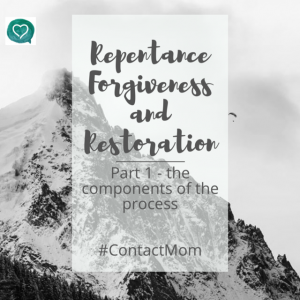Conflicts are a normal part of family life. With four boys at home, resolving conflict was a regular occurrence at our house. I found that teaching my children to reconcile their differences biblically was the number one way that I taught them to live out the Gospel in their lives. Resolving conflict God’s way requires humility, understanding, compassion, and moral maturity. There is no greater demonstration of love, no greater testimony to the power of God in our lives, no greater picture of the Gospel at work in us than when we admit our faults and resolve our conflicts through the biblical process of repentance, forgiveness, and restoration.
In Growing Kids God’s Way, Gary Ezzo teaches that repentance and forgiveness must be understood in the context of relationship. Restoration of the affected relationship is the goal. It isn’t enough that I regret my sin or even hate it. I must regret how my actions have affected my relationship with the offended party. And when I am offended, Jesus taught that I must forgive as I have been forgiven. Furthermore, if I do not forgive my brother his sins against me, God will not forgive me. (Matthew 6:12, 14)
Here’s a look at each of the components of this process:
- Repentance – Repentance begins with the offender. The word repent means to stop, turn around, and go 180° the other way. We must recognize that when we sin, we have gone in a direction opposite of what God has commanded. To maintain our relationships with others when we have sinned, we must have both a change of heart and a change of action. We must not only admit that we were wrong but also change our actions to be consistent with our words.
- Forgiveness – To forgive means to pardon an offense and to treat the offender as if he is not guilty. Forgiveness begins with the person who is offended but for the relationship to be completely restored, both parties must agree and the offender must seek and accept the forgiveness that is offered. If the offended forgives but the offender never receives it, the restoration is incomplete and the relationship remains strained.
- Restoration – To restore is to return something to its previous condition. This is the goal of this process: to put our relationships back to a place of good will and harmony. In addition to repentance and forgiveness, restoration sometimes includes restitution – some sort of action that rights the wrong. If my offense included personal or financial injury, I would make that right by replacing, paying for, or fixing what was damaged.
We taught these principles to our children. We required them to restore broken relationships by using this process, to keep their accounts with others up-to-date, and to not harbor bitterness but to freely forgive.
The amount of time required to reconcile depended upon the seriousness of the offense and the willfulness of those involved. Minor issues could be resolved pretty quickly. An example would be when my son is admonished for speaking harshly to his brother; he quickly repents and asks for forgiveness on the spot. Forgiveness is offered and accepted and within moments we have all moved on. Major sin issues or conflicts could take much longer. We often required the offender to sit in quiet reflection until he was ready to repent and make things right. If he came out to reconcile but did not demonstrate a truly humble attitude, we sent him back until he could. There isn’t a one-size-fits-all scenario for every conflict and wisdom dictates that while we should hold our children consistently to the standard, we must take care to not exasperate them by belaboring the process.
When helping your child through this process you must consider their age, maturity, and ability to understand what you require. In part 2 of this blog, I will explain how we taught our children to work through conflict using the principles of repentance, forgiveness, and restoration.





Leave a Reply